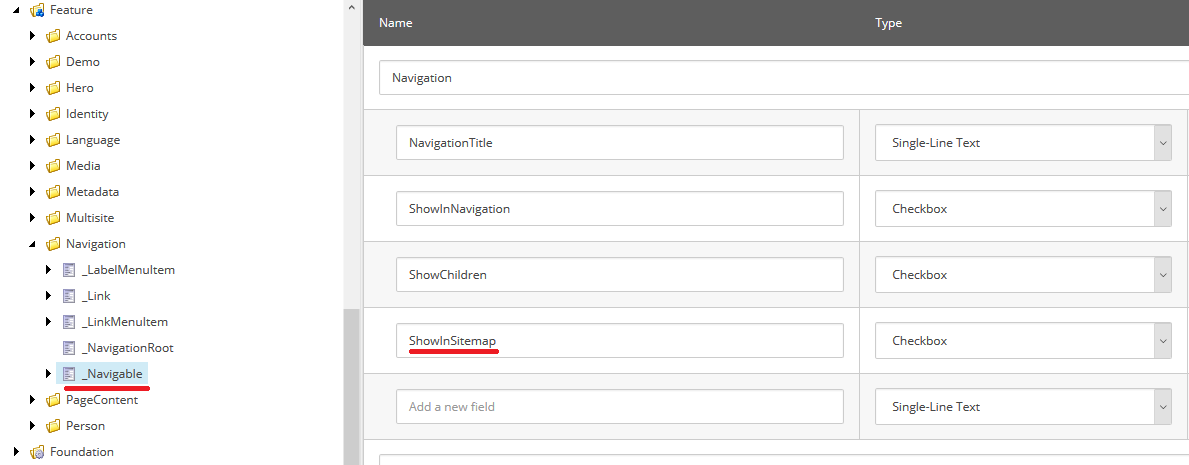I am working on a solution that already has HTML sitemap as a part of Navigation feature. Now I got a request to add also a basic XML sitemap with common set requirements. Habitat ships with an interface template _Navigable, so let's extend this template by adding a checkbox field called
ShowInSitemap, stating whether a particular page will be shown in that sitemap:

In order to start, we need to create a handler. Having handlers in web.config is not the desired way of doing things, it will require also doing configuration transform for the deployments, so let's do things in a Sitecore way (Feature.Navigation.config file):
<configuration xmlns:patch="http://www.sitecore.net/xmlconfig/">
<sitecore>
<pipelines>
<httpRequestBegin>
<processor type="Platform.Feature.Navigation.Pipelines.SitemapHandler, Platform.Feature.Navigation"
patch:before="processor[@type='Sitecore.Pipelines.HttpRequest.CustomHandlers, Sitecore.Kernel']">
</processor>
</httpRequestBegin>
<preprocessRequest>
<processor type="Sitecore.Pipelines.PreprocessRequest.FilterUrlExtensions, Sitecore.Kernel">
<param desc="Allowed extensions">aspx, ashx, asmx, xml</param>
</processor>
</preprocessRequest>
</pipelines>
</sitecore>
</configuration>
We rely on httpRequestBegin pipeline and incline our new SitemapHandler from Navigation feature right before CustomHandlers processor.
SitemapHandler is an ordinary pipeline processor for httpRequestBegin pipeline, so is inherited from HttpRequestProcessor:
public class SitemapHandler : HttpRequestProcessor
{
const string sitemapHandler = "sitemap.xml";
private readonly INavigationRepository _navigationRepository;
public SitemapHandler()
{
_navigationRepository = new NavigationRepository(RootItem);
}
public override void Process(HttpRequestArgs args)
{
if (Context.Site == null
|| args == null
|| string.IsNullOrEmpty(Context.Site.RootPath.Trim())
|| Context.Page.FilePath.Length > 0
|| !args.Url.FilePath.Contains(sitemapHandler))
{
return;
}
Response.ClearHeaders();
Response.ClearContent();
Response.ContentType = "text/xml";
try
{
var navigationItems = _navigationRepository.GetSitemapItems(RootItem);
string xml = new XmlSitemapService().BuildSitemapXML(flatItems);
Response.Write(xml);
}
finally
{
Response.Flush();
Response.End();
}
}
private Item RootItem => Context.Site.GetRootItem();
private HttpResponse Response => HttpContext.Current.Response;
}
And XmlSitemapService code below:
public class XmlSitemapService
{
public string CreateSitemapXml(IEnumerable<NavigationItem> items)
{
var doc = new XmlDocument();
var declarationNode = doc.CreateXmlDeclaration("1.0", "UTF-8", null);
doc.AppendChild(declarationNode);
var urlsetNode = doc.CreateElement("urlset");
var xmlnsAttr = doc.CreateAttribute("xmlns");
xmlnsAttr.Value = "http://www.sitemaps.org/schemas/sitemap/0.9";
urlsetNode.Attributes.Append(xmlnsAttr);
doc.AppendChild(urlsetNode);
foreach (NavigationItem itm in items)
{
doc = CreateSitemapRecord(doc, itm);
}
return doc.OuterXml;
}
private XmlDocument CreateSitemapRecord(XmlDocument doc, NavigationItem item)
{
string link = item.Url;
string lastModified = HttpUtility
.HtmlEncode(item.Item.Statistics.Updated.ToString("yyyy-MM-ddTHH:mm:sszzz"));
XmlNode urlsetNode = doc.LastChild;
XmlNode url = doc.CreateElement("url");
urlsetNode.AppendChild(url);
XmlNode loc = doc.CreateElement("loc");
url.AppendChild(loc);
loc.AppendChild(doc.CreateTextNode(link));
XmlNode lastmod = doc.CreateElement("lastmod");
url.AppendChild(lastmod);
lastmod.AppendChild(doc.CreateTextNode(lastModified));
return doc;
}
}
Also, NavigationItem is a custom POCO:
public class NavigationItem
{
public Item Item { get; set; }
public string Title { get; set; }
public string Url { get; set; }
public bool IsActive { get; set; }
public int Level { get; set; }
public NavigationItems Children { get; set; }
public string Target { get; set; }
public bool ShowChildren { get; set; }
}
Few things to mention.
1. Since you are using LinkManager in order to generate the links, you need to make sure you have full URL path as required by protocol, not the site-root-relative path. So you'll need to pass custom options in that case:
2. Once deployed to production, you may face an unpleasant behavior of HTTPS links generated along with 443 port number (such as . That is thanks to LinkManager not being wise enough to predict such a case. However there is a setting that make LinkManager works as expected. Not obvious
var options = LinkManager.GetDefaultUrlOptions();
options.AlwaysIncludeServerUrl = true;
options.SiteResolving = true;
LinkManager.GetItemUrl(item, options);
or better option in Heliix to rely on Sitecore.Foundation.SitecoreExtensions:
item.Url(options) from
//TODO: Update the code with the recent
That's it!